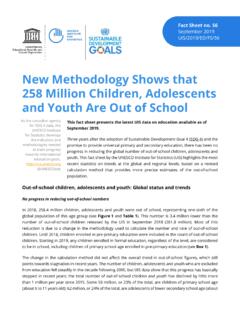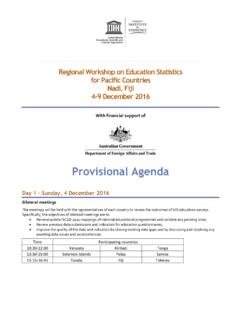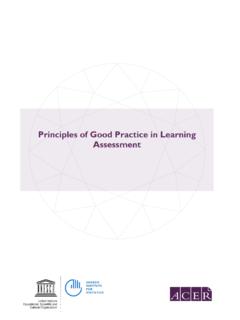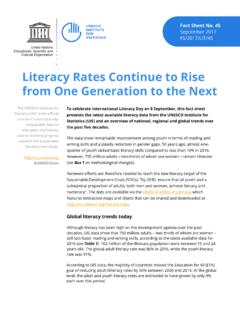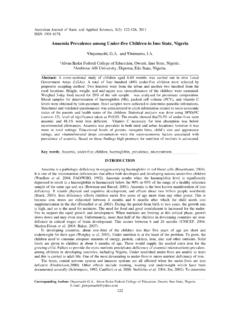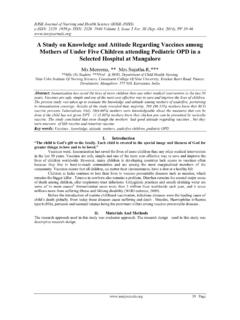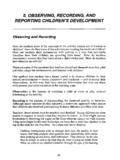Transcription of One in Five Children, Adolescents and Youth is Out of School
1 Fact Sheet No. 48 February 2018 UIS/FS/2018/ED/48 One in five children , Adolescents and Youth is Out of School This fact sheet presents the latest UIS data on education available as of February 2018. Three years after the adoption of Sustainable Development Goal 4 (SDG 4) and the promise to provide universal primary and secondary education, there has been no progress in reducing the global number of out-of- School children , Adolescents and Youth . As the SDG 4 Education 2030 Steering Committee meets in Paris, the UNESCO Institute for Statistics (UIS) has released this fact sheet, highlighting trends at the global and regional levels, to inform discussions and provide stakeholders with the data needed to target policies, strategies and resources to get all children , Adolescents and Youth in School and learning.
2 Out-of- School children , Adolescents and Youth : Global status and trends No progress in reducing out-of- School numbers In 2016, 263 million children , Adolescents and Youth were out of School , representing nearly one-fifth of the global population of this age group (see Figure 1 and Table 1). The number of children , Adolescents and Youth who are excluded from education fell steadily in the decade following 2000, but UIS data show that this progress essentially stopped in recent years; the total number of out-of- School children and Youth has declined by little more than 1 million per year since 2012.
3 Some 63 million, or 24% of the total, are children of primary School age (about 6 to 11 years old); 61 million, or 23% of the total, are Adolescents of lower secondary School age (about 12 to 14 years old); and 139 million, or 53% of the total, are Youth of upper secondary School age (about 15 to 17 years old). The UNESCO Institute for Statistics (UIS) is the statistical office of UNESCO and is the UN depository for global statistics in the fields of education, science and technology, culture and communication. @UNESCO stat 2 UIS Fact Sheet No. 48 | February 2018 The rates of out-of- School children , Adolescents and Youth have followed a similar trend (see Figure 2).
4 After an initial decline in the years after 2000, the primary out-of- School rate has barely moved from around 9% since 2008 and the lower secondary out-of- School rate has been at 16% since 2012. The upper secondary out-of- School rate, which was initially at much higher levels than the primary and lower secondary out-of- School rates, has fallen more steadily since 2000, but this trend is flattening out, with the most recent estimate at 36%. 3 UIS Fact Sheet No. 48 | February 2018 Upper secondary School -age Youth are four times as likely to be out of School as children of primary School age and more than twice as likely to be out of School as Adolescents of lower secondary School age.
5 The high out-of- School rates for older cohorts can be explained by poverty and a variety of other reasons: many Youth never had a chance to enter School when they were younger, upper secondary education is often not compulsory, and upper secondary School -age Youth may choose employment over continuing their education (UIS and GEMR, 2016). SDG 4 and the commitment to provide universal secondary education have led to a growing focus among policymakers and advocates on the number of Youth not in employment, education or training (NEET), which is discussed in Box 1.
6 4 UIS Fact Sheet No. 48 | February 2018 Box 1. Youth not in employment, education or training (NEET) Out-of- School rates tend to increase with age as Youth find or search for employment. But to what extent do they have the skills to find a first job, for example? Data on employment and vocational training provide an important perspective on the share of out-of- School Youth either working or preparing for the job market. But additional sources of information are needed to gauge the extent to which Youth are not in employment, education or training (NEET).
7 SDG Target calls for a substantial increase in the number of Youth and adults who have relevant skills, including technical and vocational skills, for employment, decent jobs and entrepreneurship. To monitor this target, additional indicators are required, especially on skills. The risk of falling within the NEET category is generally associated with low educational attainment and weak information-processing skills, such as poor literacy and numeracy. As part of efforts to respond to the need for better data, the UIS is examining if the Youth NEET rate for the population aged 15 to 24 years could represent a valuable indicator.
8 Specific questions studied by the UIS include: What relation exists between Youth NEET and Youth levels of educational attainment? How could NEET rates by sex, age group, location, educational attainment and national income inform basic skills acquisition by Youth and their preparation for labour market entry? This work by the UIS makes use of NEET data produced by the International Labour Organization (ILO). The NEET rate is a well-established measure that is also the official indicator for SDG Target ( By 2020, substantially reduce the proportion of Youth not in employment, education or training ).
9 Currently, NEET data are available for nearly 100 countries. Preliminary results from the analysis by the UIS were presented to the Technical Cooperation Group on SDG 4 Education 2030 Indicators (TCG), which met in January 2018. The TCG endorsed the work by the UIS and requested a progress report at a future meeting. 5 UIS Fact Sheet No. 48 | February 2018 Table 1. Out-of- School rates and numbers by SDG region, 2016 Out-of- School children of primary School age Region Out-of- School rate (%) Out-of- School number (millions) Both sexes Male Female GPIA Both sexes Male Female Europe and Northern America Latin America and the Caribbean Central Asia Southern Asia Eastern and South-Eastern Asia Northern Africa and Western Asia Sub-Saharan Africa Oceania World Out-of- School Adolescents of lower secondary School age Region Out-of- School rate (%) Out-of- School number (millions)
10 Both sexes Male Female GPIA Both sexes Male Female Europe and Northern America Latin America and the Caribbean Central Asia Southern Asia Eastern and South-Eastern Asia Northern Africa and Western Asia Sub-Saharan Africa Oceania World Out-of- School Youth of upper secondary School age Region Out-of- School rate (%) Out-of- School number (millions) Both sexes Male Female GPIA Both sexes Male Female Europe and Northern America Latin America and the Caribbean Central Asia Southern Asia Eastern and South-Eastern Asia Northern Africa and Western Asia Sub-Saharan Africa Oceania World Out-of- School children , Adolescents and Youth of primary, lower secondary and upper secondary age Region Out-of- School rate (%) Out-of- School number (millions)
